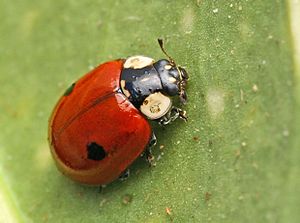Two-spotted lady beetle facts for kids
Quick facts for kids Two-spotted lady beetle |
|
|---|---|
 |
|
| Scientific classification |
The two-spotted lady beetle (also called the two-spot ladybird or Adalia bipunctata) is a type of beetle. It belongs to the ladybird family (Coccinellidae). These beetles eat other insects. You can find them in many parts of the world, especially in Europe and North America. People often bring them to new places to help control pests naturally.
Contents
Understanding the Two-Spotted Ladybird's Name
The famous scientist Carl Linnaeus first described the two-spotted ladybird in 1758. He gave it the name Coccinella bipunctata. The name bipunctata comes from Latin words. "Bi-" means "two," and "punctata" means "spotted." So, its name literally means "two-spotted ladybird."
What Does a Two-Spotted Ladybird Look Like?
Adalia bipunctata is a small ladybird. It can have many different patterns of red and black. The most common type has two black spots on a red body.
Sometimes, you might see a darker version. This type is mostly black with four or six red spots. There are also very rare forms that are almost completely black. In North America, these ladybirds show even more variety. Some have no spots, some have four bands, and others have many spots, from nine to twelve.
You can tell Adalia apart from similar beetles by looking at its head. It has two white spots on its head. Also, its belly and legs are completely black.
What Do Two-Spotted Ladybirds Eat?
Two-spotted lady beetles are helpful insects. They mostly eat aphids. Aphids are tiny insects that can harm plants. Ladybirds also eat other small insects. Sometimes, special "soldier" aphids try to protect their colony by fighting off the ladybirds.
The Life Cycle of a Two-Spotted Ladybird
The life cycle of the two-spotted lady beetle is fascinating. It starts with tiny eggs.
From Egg to Larva
Ladybirds usually lay their eggs in groups. A tiny larva hatches from each egg. This larva looks very different from an adult ladybird. It has a long, grey, soft body with six legs. It does not have wings. These larvae can sometimes eat other ladybird larvae.
Growing Up: Larval Stages
A larva grows by eating a lot. As it grows, it sheds its old skin. This process is called molting. It goes through four molting stages. The last larval stage is about the same size as an adult beetle.
Becoming a Pupa
Once the larva has eaten enough, it attaches itself to a surface. Then, it changes into a pupa. Inside the pupa, the ladybird slowly changes into its adult form.
The Adult Ladybird
Finally, the adult ladybird comes out of the pupa. It is now ready to mate and start the cycle all over again.
Special Facts About Ladybird Populations
Sometimes, in certain groups of ladybirds, there are many more females than males. This happens because of tiny bacteria that live inside the female ladybirds.
How Bacteria Affect Ladybirds
These special bacteria can only be passed on through female eggs. If a male gets the bacteria, it won't pass them on. So, the bacteria cause most of the male ladybird embryos to not develop. This means more female ladybirds are born. These bacteria are found in some ladybird populations, but not all.
Tiny Mites and Ladybirds
Two-spotted ladybirds can also get an infection from a tiny mite called Coccipolipus hippodamiae. This mite can move from one ladybird to another when they mate. If a female ladybird gets this mite, it can make it hard for her to have babies. In some places, many adult ladybirds can get infected.
Ladybirds as Natural Pest Control
A. bipunctata is very useful for controlling pests. People use them to fight aphids in places like greenhouses. These ladybirds were even brought to Australia specifically to help control pests naturally.
See also
 In Spanish: Mariquita de dos puntos para niños
In Spanish: Mariquita de dos puntos para niños







